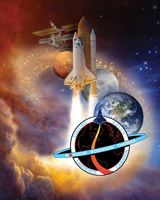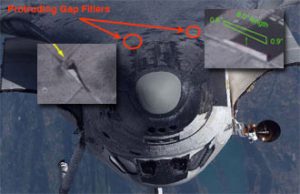August 3, 2005
 I’m back home in Alabama. In fact, I have been working at Marshall Space Flight Center in Huntsville this week. I got home to Tuscaloosa around 10:00 p.m. Friday night, spent the weekend recovering from last week’s travels, and got up at 5:00 a.m. Monday morning to come to work here at Marshall where I serve as the Center’s University Affairs Officer. I will be returning to Tuscaloosa Thursday afternoon.
I’m back home in Alabama. In fact, I have been working at Marshall Space Flight Center in Huntsville this week. I got home to Tuscaloosa around 10:00 p.m. Friday night, spent the weekend recovering from last week’s travels, and got up at 5:00 a.m. Monday morning to come to work here at Marshall where I serve as the Center’s University Affairs Officer. I will be returning to Tuscaloosa Thursday afternoon.
Since my last blog, it has been a very interesting time with STS-114. Of most interest to me has been the discovery of two pieces of protruding gap filler between tiles in the heat shield on the underside of the orbiter Discovery. See the below image provided by NASA that illustrates their location on the Orbiter as well as the size of the protrusion.
We’ve had orbiters return to Earth previously and discovered protruding gap fillers, but never protruding as far as these two did. The related engineering issue is that they would cause increased (above the norm) heating downstream of their locations upon reentry. Since NASA could not predict exactly how much the increased heating would be, the decision was rendered to perform an on-orbit repair. This was a first for the agency–to attempt to repair the heat shield while on-orbit. Needless to say, a great deal of ground-testing of the procedure was performed this week before the real thing took place this morning. The plan was for mission specialist Steve Robinson to ride the Station’s robot arm to get “underneath” the Shuttle and remove the gap fillers. The plan was that Robinson would give it a gentle tug with his fingers (space gloves are much better than they used to be!). If that didn’t work, then to try to do it with forceps. If that didn’t work, then to saw it off.
 The robot arm was operated by our own Vegas Kelly and by mission specialist Wendy Lawrence. It was a great treat this morning to hear Jim’s voice as he communicated with Steve Robinson as they were maneuvering the arm to get Robinson into the right location under the Orbiter. As I’m sure that all of you know by now, it went off without a hitch as Robinson was able to pull out the gap filler with his fingers and we have now successfully performed our first on-orbit repair of the Shuttle’s heat shield!
The robot arm was operated by our own Vegas Kelly and by mission specialist Wendy Lawrence. It was a great treat this morning to hear Jim’s voice as he communicated with Steve Robinson as they were maneuvering the arm to get Robinson into the right location under the Orbiter. As I’m sure that all of you know by now, it went off without a hitch as Robinson was able to pull out the gap filler with his fingers and we have now successfully performed our first on-orbit repair of the Shuttle’s heat shield!
From a different angle, there has been a great deal of negativity in the media this week because of the foam debris problem. What seems to be forgotten here is that this is a test vehicle and the improvements made by NASA since the Columbia tragedy resulted in 80 percent fewer “dings” in the Orbiter than has been typical. Exploration is risky, but is worth doing. We need a human presence in that process and must be as safe as possible, but as a society we have to understand that there will always be risk.
You know, I have a story about Jim Kelly that I have told some people and will now tell again:
Vegas was selected for astronaut training in 1996 just prior to completing all requirements for his master’s degree in aerospace engineering at UA. We had just hired Dr. Andrew Sorenson as our new president of the University, and he learned of Jim’s astronaut selection and coming graduation and decided that we would have a special graduation ceremony for him, which we did. It was held over in the Bryant Conference Center at lunch one day before a room full of dignitaries. Jim was, of course, at the head table. I had been invited to sit at the head table also and to make a few remarks about distance learning from the perspective of a faculty member. As I have mentioned previously, I taught Vegas in three of the eight graduate courses that he took in our program. Well, the event moderator acknowledged some of the dignitaries (state legislators, local politicians, etc.) in the audience. I was sitting next to Jim and you have to remember that this was his first visit to the University and he wasn’t making any notes on those individuals. Then he was introduced to make a few remarks. Now he, of course, had prepared his remarks, but in his talk he tuned his remarks to say something appropriate to almost every single one of those dignitaries. Mighty impressive demonstration of his gifts as a public speaker! Now, the downside for me was that I had to follow him to the podium and I am not that gifted a speaker. The lesson for me was to be careful whom you follow to the podium!
Later, as the mission progresses…
– – – – – – – – – – – – – –
RELEVANT LINKS:
EDITOR’S NOTE: Dr. Michael Freeman is an Associate Professor of aerospace engineering and mechanics at The University of Alabama. He is attending this week’s launch of the space shuttle Discovery, and will publish daily accounts of the events surrounding the shuttle’s “return to flight” launch. UA graduate James Kelly is the pilot of STS-114, NASA’s first space flight in over two years. Dr. Freeman may be reached by e-mail at michael.freeman@ua.edu.